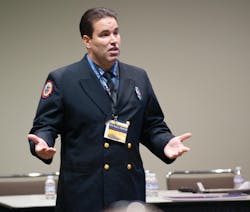Experts Say to Push Fire Prevention Year-Round
“One of our biggest challenges is keeping in touch with people year round,” said Daniel Byrne, a firefighter/paramedic with the Burton (S.C.) Fire Department. “Fire prevention can’t be only one time a year, it has to be year-round.”
This year, the National Fire Protection Association’s (NFPA) theme centered on protecting families, but Lee Levesque, a firefighter and public affairs officer for the Lady’s Island St. Helena (S.C.) Fire District, said there’s no reason for it to be just a one-day or one-week long event.
“When we look at our compadres, the teachers in the schools, they have recognized that year-round education helps with retention,” Levesque said, adding that the same principle holds with fire safety education. “I am doing the same this week as I did last week and the week before that,” he said.
Byrne said departments are “missing the boat” if they don’t make the time and expend the energy to get the word out as often as possible, irrespective of the date on the calendar.
One of the challenges facing Byrne is at-risk families who may distrust authority figures and do not respond to a once-a-year interaction with firefighters.
“You’ve got to get out into your communities and interact with people, find out who the neighborhood leaders are and get to know them,” Byrne said.
Unfortunately, Byrne said, too many firefighters find that kind of interaction a chore that is forced upon them by chiefs who make it a requirement. Under those circumstances, the firefighters don’t have the right attitude and the interactions, if they happen at all, are negative.
In general, Byrne said the public doesn’t fear firefighters, at least not as much as they might compared to police officers, so there’s a natural advantage to try to promote fire safety to people who are receptive. Again, he said, the key is positive, continuous interaction with the people served.
Levesque said firefighters should take advantage of every opportunity they can to get fire safety messages out to the public. A parade is a perfect place to hang a banner to reinforce a message that may have been given out during fire prevention week.
“We need to use regular media, social media and all other venues to get the message of public safety out there,” Levesque said.
A goal for all fire departments should be to become the clearing house for all things related to safety, Levesque said, from swimming to smoke detectors and fire extinguisher use.
“We are already the go-to, all-hazards agency,” he said.
Firefighters have a better chance at getting the message out there than others because they’re not seen as “pushy salesmen or religious nuts,” so the public is more receptive to listening to the department’s messages, Levesque said.
Levesque’s department does what it calls a “fire blitz” after ever major fire. That’s a practice of visiting every house and business within a five block area immediately after a big fire, he said. The concept is to use the event as a teaching moment. The neighbors might have questions and the fire is fresh in their minds, he said.
“Sometimes, that will allow us to get inside to install a smoke detector, or a fire extinguisher and maybe do a quick fire safety inspection, if they allow us to go in,” Levesque said. “We tell them we just want to help them be even safer. Sometimes it works, and sometimes it doesn’t. Sometimes they even give us cookies.”
For those folks who are not home, the department leaves messages on door knobs with contact information and other information, Levesque said.
Byrne said any time firefighters can get into homes is a good thing. It allows firefighters to do a quick size-up and see what kinds of hazards they might face if a blaze ever occurred at the address.
Hosting community events, grilling up hot dogs, and offering free prizes will also get people out to listen to fire safety messages, Byrne said.
“Who wouldn’t come out for a free $25 gift card?” he said, noting there’s an added benefit to having interactions outside of an emergency situation.
To get funding for those kinds of programs, free smoke detectors, extinguishers and gift cards, there are grants that can be written and businesses to be solicited, both Byrne and Levesque said.
“You’ve got to be willing to fill out the paperwork and jump through the hoops to get it, but it’s worth it for the people we serve,” Levesque said. “We (firefighters) don’t like to do that sometimes, but hey, it’s important.”
Departments also ought not be shy about participating in business sponsorships, Levesque said. If a business gives money for smoke detectors and fire extinguishers, the department ought to be willing to reciprocate with free publicity or even store appearances with apparatus, he said.
Departments can often get bogged down with paying homage to municipal officials rather than the taxpayers and residents, Levesque said, and that should change.
“Too often, we’re paying attention to those who stroke the checks,” Levesque said, “rather than those who we protect.”
